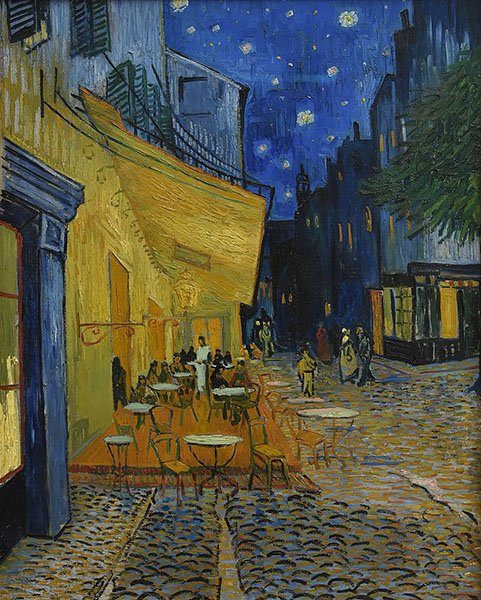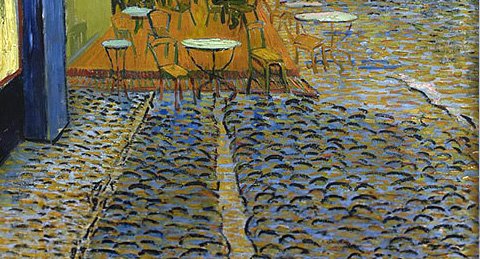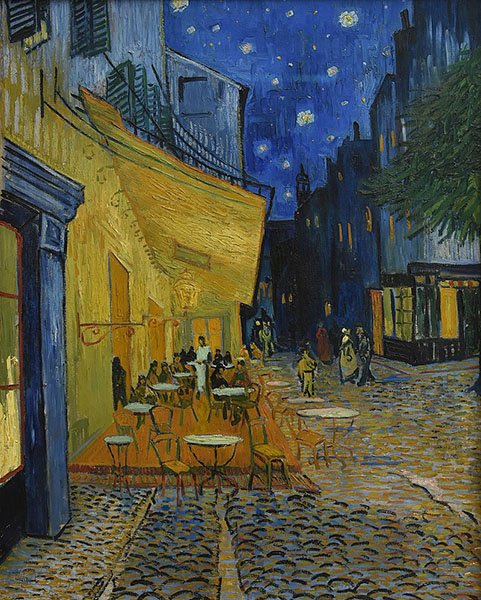
Vincent van Gogh’s “Café Terrace at Night,” painted in September 1888, is more than just one of his most renowned works; it has also become a cultural icon, celebrated worldwide. Created during Van Gogh’s stay in the charming town of Arles, France, this vibrant depiction of a lively evening scene under a starry sky has transcended its time, embedding itself in popular culture.
The painting’s enduring appeal lies not only in its artistic brilliance but also in its widespread cultural resonance. “Café Terrace at Night” has been referenced in various films, literature, and music, symbolizing the intersection of art and everyday life.
Critically, the painting has been lauded for its innovative use of color, particularly Van Gogh’s masterful contrast between the vibrant yellow of the café and the deep blue of the night sky. This bold use of complementary colors has been widely studied and celebrated, contributing to Van Gogh’s reputation as a pioneer in color theory. Over the years, art critics have praised the work for its ability to convey both the intimacy of the café scene and the vastness of the night sky, reflecting the dualities that Van Gogh often explored in his work.
Today, “Café Terrace at Night” is housed in the Kröller-Müller Museum in Otterlo, Netherlands, where it continues to draw visitors from around the globe. Although it has not been sold in recent history, its estimated worth is in the hundreds of millions of dollars, underscoring its significance in the art world.
“Café Terrace at Night” is more than a historical artifact; it is a living piece of culture that continues to inspire and captivate. As we delve deeper into the intricate details of this masterpiece, we’ll explore not only the techniques and perspectives that Van Gogh employed but also the lasting impact this work has had on both art and society.
The Sky: Starry Sky With A Twist
The Sky in Vincent Van Gogh’s Cafe Terrace At Night is where Van Gogh’s love for cosmology shines through. In a letter to his brother Theo, Van Gogh wrote, “When I have a terrible need of—shall I say the word—religion, then I go out and paint the stars.” This statement encapsulates his view of the night sky as a spiritual entity, a place where he could connect with something greater than himself.
Painted in September 1888, the sky is a dazzling cobalt blue, punctuated by stars that almost appear to pulsate with light.
Unlike in his later masterpiece, “The Starry Night,” where the sky swirls with energy, here the stars are calmer, more orderly. Van Gogh used short, deliberate brushstrokes to create the texture of the sky, which contrasts with the chaotic and almost feverish strokes seen in “The Starry Night.”
The peaceful, yet vibrant, night sky serves as a serene backdrop to the lively scene below, embodying Van Gogh’s deep connection to the natural world and his desire to convey the emotional atmosphere of a place.


The Buildings: A Play Of Light and Shadow
The buildings in the painting, especially the yellow café on the left, are depicted with thick, expressive strokes. The café itself glows under the artificial light, a warm contrast to the cool, shadowy tones of the surrounding structures. Van Gogh’s use of complementary colors—yellow and blue—creates a striking visual harmony, making the scene appear almost three-dimensional.
The upper floors of the buildings recede into darkness, adding depth and a sense of mystery to the composition. This use of light and shadow demonstrates Van Gogh’s mastery in manipulating color to evoke mood and space, a technique he developed through his studies of Japanese prints and the works of the Impressionists.
The Cafe: A Social Hub Under The Night Sky
The café terrace, with its inviting glow, is the focal point of the painting. Van Gogh’s brushwork here is energetic yet controlled, capturing the lively atmosphere of the café. The bright yellow light spilling onto the terrace draws the viewer’s eye and creates a sense of warmth and conviviality.
This light is not just a visual element but also a symbol of human connection, a theme that Van Gogh explored throughout his career. The figures seated at the tables, though not detailed, convey a sense of community, their presence bringing life to the otherwise quiet night. This part of the painting reflects Van Gogh’s fascination with the social aspect of cafés, which he often visited to observe and sketch the people around him.


The Cobblestone Pathway: Journey Into The Scene
The cobblestone pathway leading up to the café is rendered with rhythmic, almost hypnotic strokes, guiding the viewer into the painting. The stones are painted in a mix of blues, yellows, and browns, echoing the colors of the buildings and sky. This pathway not only grounds the composition but also adds to the painting’s sense of depth and perspective. Van Gogh’s technique here, with its repetitive patterns and use of color, draws on the influence of Neo-Impressionism, particularly the pointillism of Georges Seurat, while also reflecting his own unique style. The path invites the viewer to step into the scene, to walk along the cobblestones, and to experience the night as Van Gogh did.
The Background: A Glimpse Into The Quiet Town
In the background, beyond the café, the town of Arles is shrouded in darkness, with only a few windows lit by the soft glow of lamplight. This part of the painting contrasts sharply with the brightly lit café, highlighting the isolation and quietude of the town at night. The distant figures walking in the street add to the sense of solitude, their small size emphasizing the vastness of the night sky above. Van Gogh’s decision to include this quiet, almost deserted street speaks to his own feelings of loneliness and his complex relationship with the townspeople of Arles, who often regarded him with suspicion.
The Final Composition: Beyond The Art
“Café Terrace at Night” is more than just a depiction of a night out in Arles; it is a masterful exploration of light, color, and human emotion. Through his innovative techniques and deep understanding of color theory, Van Gogh was able to create a scene that is both inviting and introspective, capturing the essence of a moment in time while also conveying the artist’s own inner world. Each element of the painting, from the starry sky to the cobblestone path, contributes to the overall narrative, making it one of Van Gogh’s most celebrated works.
At Bombay Art Company, Vincent van Gogh's "Café Terrace at Night" is available for you to bring into your own space. Whether you prefer a high-quality art paper print, a canvas reproduction, or a beautifully framed version, we offer options that suit every taste and décor.
Explore our World Collection to discover "Café Terrace at Night" and other renowned works by Van Gogh. Simply search for "Café Terrace" or "Vincent Van Gogh" on our website to find this masterpiece and make it a part of your collection. You can also browse our World Collection to explore more timeless paintings

